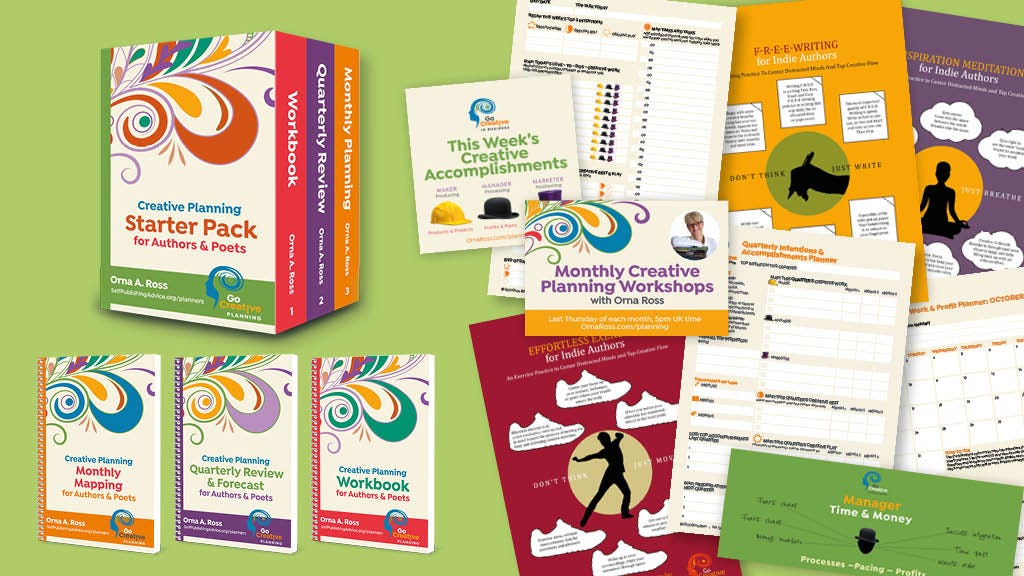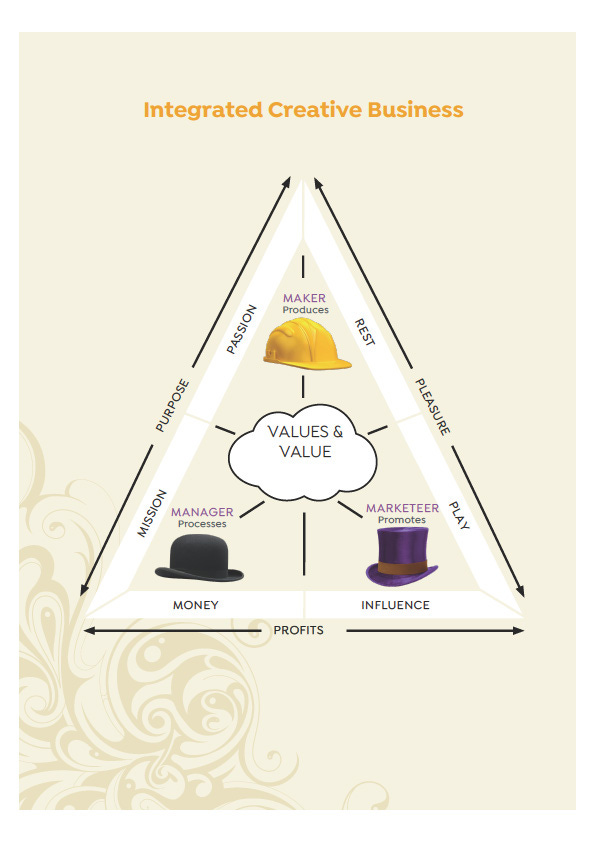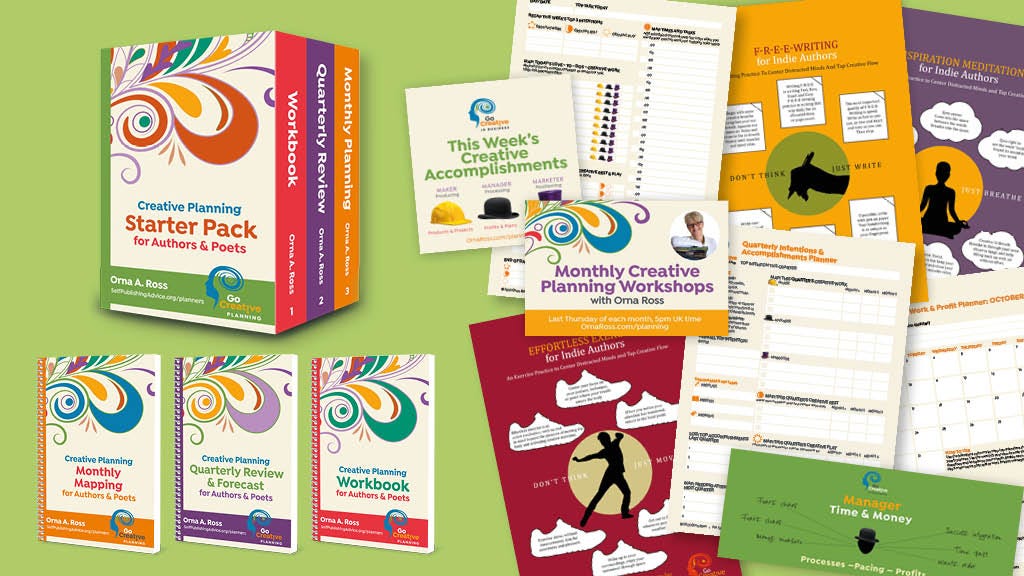Ink and Intent: How Creative Planning Uplifts Authors and Poets
Being an author is a thrilling and empowering adventure... but the vast array of possibilities can be overwhelming. Let's talk about how to tackle your goals without taking on too much at once.
Orna Ross is a powerhouse in the indie author space, so when she told me she had a Kickstarter going for a new planner, I got very excited and asked her to write an article all about planning.
If you are a paid member, I recommend reading the Mindset section of How To Become a Successful Author, the Making Great Content section of How to Build Your Creative Career, and taking the Write a Great Novel course that came with your subscription.
If you are not a paid member, you can read everything with a 7-day free trial, or give us a one-time tip.
I’ve been a fan and member of ALLi (The Alliance for Independent Authors) since way before I joined their advisory board as a crowdfunding expert.
Admittedly, I joined specifically for their IngramSpark codes to get free revisions and uploads back before Ingram loosened their pricing, but have slowly found so many things to love about the alliance that can help all authors. I’ve been interviewed by their podcast and been a part of their virtual conference.
Not the least of the reasons I love ALLi is their founder-director Orna Ross. Orna is a powerhouse writer in her own right, but amplified by ALLi she is a force for good in the author community.
So, when she told me she had a Kickstarter live right now for her new Go Creative! Planning Program for Authors & Poets, I got very excited and asked if she would write a piece for us all about planning.
Before we get to it, I just want to say how much I love this planner. I’m not a planner human, but game recognizes game, and this is a great planner. You should definitely check it out.
Being an author, especially an indie author, is a thrilling and empowering adventure... but the vast array of possibilities and opportunities open to us—genres to explore, tools to employ, platforms to manage, marketing strategies to adopt—can be overwhelming.
The gap between where we are and where we want to be is full of creative challenges.
If we don't know how to recognize those challenges and respond creatively to them, we can get lost and find ourselves floundering or failing, blocked or burnt out.
Each individual author needs a way to integrate all the advice and opportunities into creative processes. Creativity being what it is, there is no single way that works best for all. There is, however, a way that works best for you. That's what creative planning uncovers.

What is Creative Planning for Authors?
Creative planning for authors is a holistic approach that integrates personal values, artistic vision, and practical strategies to navigate the complexities of writing and publishing. It’s all about containing and arranging your creative capacity (energy, talent, ideas) and conditions (time, money, relationships), to deliver ever-expanding productivity, profits, and pleasure.
And doing so in an integrated and harmonious way. What this translates to in your life is a sense of peace and order that generates more and better output, without stress or over-busyness. creative expansion and flow.
A few years ago, I developed a method of creative planning that delivered these results for me and now I am sharing them with other authors. I call it the Go Creative! planning method and it’s based on ten core planning principles, for indie authors and poets.

Go Creative! Planning Principle #1: Integrate first
A successful creative business integrates profits, pleasure, and a sense of purpose, so let go of any oppositional thinking that may be holding you back. e.g. “I love writing but I hate marketing.” “Art is good, money is evil.” “As a writer, I’m an artist, as a publisher I’m a businessperson.”
Creative planning is all about integrating the different aspects of your activities as an indie author—writing and publishing, purpose and profits, income and influence—and the different aspects of yourself as a person (see diagram).
Before you dive into your work, you stop and listen to yourself. Go Creative! planning uses f-r-e-e-writing as a tool for this deep listening. F-r-e-e-writing (writing fast, raw, and exact-but-easy) gives a space to all your selves—the parts that want to resist, block, and limit, as well as the parts that want to create, grow, and expand.
You can’t expand by suppressing parts of yourself that you’ve labeled wrong or bad. You can’t grow by cutting part of yourself off.
Each part of you, even the resister and blocker, has value to offer the whole. Walt Whitman said it well: “I am large. I contain multitudes.” Creative planning allows your largest, most multitudinous self to find full expression.

Go Creative! Planning Principle #2: Plan with Pen and Paper
Multiple studies provide evidence that handwriting engages different parts of the brain than typing, leading to improvements in cognitive function, learning, and memory recall. The process of handwriting slows your thinking processes and fosters more focused, intentional, creative, and expressive ideas. This is totally my own experience and the experience of the authors I’ve worked with.

Go Creative! Planning Principle #3: Value your Values
Begin your planning by exploring your own personal values and draw connections between these values and the value you offer to readers in your book. This alignment of values, as embodied in your personal mission and passion and sense of purpose as a writer and publisher, is a massive shortcut to reaching and resonating with the right readers for your work. Such values-based creative planning activates the kind of reader response that grows word of mouth.

Creative Planning Principle #4: Embrace Mess and Failure
Creative planning recognizes that the creative process is inherently non-linear and unpredictable. While some structure is essential for progress and goal achievement, too much can stifle creativity. The key is finding the balance that works for you, planning time for focused work, and also for spontaneity and exploration.
Instead of a strict schedule, creative planning is a framework allowing for flexibility and adaptability. It provides a roadmap that can accommodate sudden bursts of inspiration, periods of reflection, the inevitable roadblocks, and surprising swerves onto the scenic route.
And it embraces failure as an integral part of the process, viewing setbacks as valuable opportunities for reflection and growth. A feedback loop that shows how to refine the work and the strategies used to produce and promote it.
You will get things wrong, overreach yourself, make mistakes, fall down. Admit where it went astray, take the learning, and open yourself to growth.
Go Creative! Planning Principle #5: Important Before Urgent
What’s most important is rarely what’s most urgent. Know the difference between the two and know what’s most important to you. Then narrow down. Enjoy the freedom that’s found in focus. This means working out what you need to delete, defer or delegate, then doing the work it takes to release them.
On the writing side, prioritize writing new words over responding to non-urgent emails or social media notifications. On the publishing side, focus on long-term strategies like building email lists, cultivating relationships with book influencers and readers, and direct sales over scattergun promotions.

Creative Planning Principle #6: Top Task First.
What’s done first in the day gets done. Show up each day, as early as you can, for what you’ve identified as most important to you. For indie authors, that’s usually writing, but whatever it is, be aware of the top task you want to achieve this year, quarter, month, week, day, moment.
Then do what you said you’d do. Sometimes you won’t or can’t, but if you don’t today, do show up tomorrow.

Go Creative! Planning Principle #7: Wear Three Hats
One reason being an indie author is challenging is because we must balance the demands of three very different kinds of work: producing, processing, and promoting. Or to put it another way: being the creative artist, the creative director, and the creative promoter of your books.
At a practical level, that means we must wear three hats: maker, manager, and marketeer. The better we are at each of these, the more we understand their different energies and how to plan their activities in a balanced way, the more money we generate from our publishing.
And the more meaning we generate too, for everyone who is touched by our work—not least ourselves.

Go Creative! Planning Principle #8: Invest in Others
Plan how much time and money you are going to invest in your books and your business. Pay attention to return on investment, not cost—something can be expensive and deliver a better return than a cheaper option and there is always the cost of not investing that must also be considered. Plan to outsource tasks that don’t draw on your strengths. Focus on the important stuff that only you can do. And plan investment in courses or workshops that improve your writing and publishing craft. Plan and implement activities that improve your relationship with money, so it becomes a positive force in your publishing business and your life.

Go Creative! Planning Principle #9: Pay Yourself First
Invest in yourself first. The Go Creative! planning method is based around allocating percentages of your business income across four bank accounts: expenses, salary, profit, tax. If you wait until you have enough left over after you’ve paid the tax collectors, editors, designers, and all the other expenses of writing and publishing, it most likely will never happen.
Segment your income into expenses, salary, profit, and tax accounts and adjust your behaviors accordingly. Pay attention to financial flow with two dedicated money days each month in which you pay yourself (a pre-decided percentage) first.
The publishing and creative industries have undervalued writers forever. Let’s not continue that bad work. Let’s value ourselves.

Go Creative! Planning Principle #10: Find Your Flow
Connect with your own creative capacity, natural rhythms, and deepest desires by planning creative rest and play as well as work. Spend time in silence. Spend time alone. Each week, take a “create date,” a dedicated time, in solitude, where you do fun, mindless things that switch your mind off work. Move more. Writers spend far too long sitting. Learn to meditate, if you don’t already. Understand that rest and play are not breaks from the creative process. They are the process.
Creative planning meets you where you are, then activates and directs your creative energies (in all their different aspects), so you can absorb the inevitable vagaries of the author's life, and steadily move towards where you want to go, confident that you're on the right path.
If things aren't working for you, there's a reason. You're experiencing some form of creative resistance or block, and there are tried and tested processes and practices that can get you back into flow. The answers you need are inside you. Letting them speak to you is transformative.
Once you develop the skills of creative planning, you never look back. You'll never again be left wondering what to do next. You become positive, focused, and, if not exactly fearless, able to put creative anxiety in its rightful place, so you can relish the creative joys and challenges of writing and publishing, each step of the way.
If you enjoyed that article, I highly suggest you head over and check out her Kickstarter, which is live right now, but only for a few more days.
While you’re there, you can also check out our Kickstarter campaign for Direct Sales Mastery for Authors.
If you care about direct sales at all, you back this two-volume guidebook to mastering direct sales for authors that’s live on Kickstarter right now.
Monica Leonelle and I have been working on this book for basically our whole careers. This book contains a combined 25 years of hard-won practical experience from building our own direct sales empires and helping hundreds of authors build them, too.
If Author Ecosystems is the lens by which you look at direct sales, then Direct Sales Mastery for authors is the guidebook. Whether you are just thinking about direct sales or you want to take your business to the next level, this is a must-read book, and it’s available exclusively to Kickstarter backers. It won’t be on retailers for several months after we deliver it to Kickstarter. If you want to get ahead of the curve and hit 2024 running, then we hope to see you behind the backer wall.
If you enjoyed this one, consider becoming a paid member. If you are a paid member, I recommend reading the Mindset section of How To Become a Successful Author, the Making Great Content section of How to Build Your Creative Career, and taking the Write a Great Novel course that came with your subscription.
If you are not a paid member, you can read everything with a 7-day free trial, or give us a one-time tip.







“Top task first.” The first item on the day’s agenda actually gets accomplished—sooo true. How liberating that it’s not just true for me.